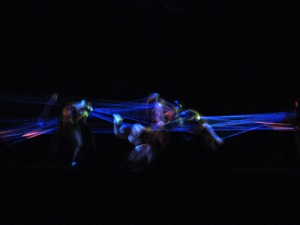
The closing scene from 'Thief', choreographed by Azwa.
Danson
26-28 December 2008
Panggung Bandaraya
It is not often that you think of contemporary dance being an art form for the people. When artists are trying to push boundaries, they are not generally trying to make something that can be easily enjoyed and understood. Nevertheless, the two can coexist, and it is important to develop audiences by starting with a bit of gentle encouragement.
Over the weekend, Dewan Bandaraya Kuala Lumpur did just this by presenting a collection of short contemporary dance works at Panggung Bandaraya. Tempted by the free admission, the public came, saw, and appreciated the experience hugely, judging by the applause, giggles and conversations audible in the pit.
The works were performed by the dancers of DBKL and MBPJ cultural troupes, and created by their inhouse and visiting choreographers. These troupes employ some of the only full-time dance performers in town – their salary, meager though it may be, allows them to perform at city council events. Their usual fare is traditional dance, mainly Malay. However, they occasionally make forays into contemporary dance, resulting in the eight short works presented for Danson.
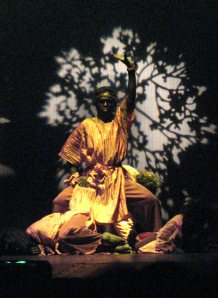
'Keliru'.
The opening work, ‘Keliru’ by Yusof Nor, featured dancers with tangled hair and black face stomping and rolling around to jungle noises, until they were overwhelmed by the entrance of the twin symbols of civilisation – fire and engineering (in the shape of a ladder planted midstage). In Australia or the US this kind of behaviour would have come under fire for its lack of political correctness, but in Malaysia its total unselfconsciousness could only be interpreted as charming. A number of children were also featured in the work, and their ability to keep up with the adults said a lot about the unrefined quality of the movement, all the better to portray dark and ignorant primitivism.
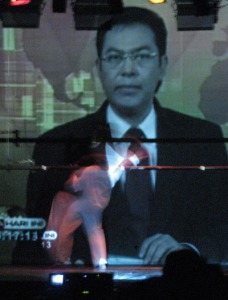
'Kenapa Ye?'
‘Kenapa Ye???’, created (and performed?) by Jasni, addressed similar themes of the challenges stemming from modernity. A single man dressed in white agonised in front of a projection of television newsreels. As in many instances of this model, the projection often overshadowed the dancing figure, which could, I suppose, be taken to underscore the dominance of media over the individual. The television footage, especially the clips taken from recent coverage of the Bukit Antarabangsa landslide, was certainly compelling. At one point, the newsreel soundtrack was replaced by a lyrical soundscape, just as the soloist was turning and twisting against a background of slowly falling landslide, and the combined effect was oddly graceful.

'Aku...I...Me'
The following work returned to a more regular crowd-pleasing model, with a tightly choreographed group work by Azwa entitled “Aku…I…Me.” Juxtaposing a single male figure, moving in a silat-influenced manner, against a small male chorus whose movements were marked more by breakdancing and hip hop, the work made good use of the rhythmic gamelan-inspired music. The starting sequence of strong body arches in time with the music was possibly the most memorable moment of movement of the evening.
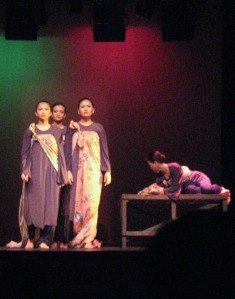
'Pangkin'.
The importance of music, or the lack of it, was shown in the following work, ‘Pangkin’, created by Jasni. Depicting a group of women in sarongs indulging in gossip and commiseration, the work featured long stretches of silence, which the audience found rather difficult to swallow. In some sections the slow sustained movement combined with silence made the audience fidget and chat, and in other parts the silence highlighted the unintentionally humorousness of the movement, resulting in infectious waves of giggles from the pit. With the music, when it appeared, also featuring a bubbling giggling motif, and the dancers switching unpredictably from sulky slowness to bright smiles, perhaps the audience can be forgiven for their bad behaviour.
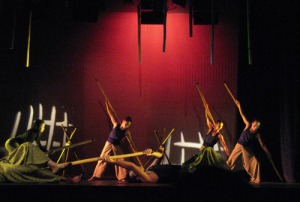
'Belebas'.
My favourite work of the evening was the next work, ‘Belebas’, choreographed by Seth. Springing from the question of whether man’s virtue can be as straight as the bamboo, a group of men and one woman explored architectural arrangements with long bamboo poles. The poles created attractive parallel shapes, occasionally interrupted by one, as if in defiance. The work showed a good eye for spatial potential, and the central section of the work, with its tighter group choreography, presented a strong moment of climax.
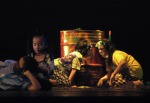
'Sengal'.
Yusof Nor’s next work, ‘Sengal’, once again featured the child performers, this time clad in goggles and flippers, teasing and arguing with one another around a large circular drum, from which the choreographer, with hesitant movements and exposed belly, periodically emerged. It was unclear if the adult figure was meant to be tragic, comic or merely pathetic, but at least the audience enjoyed the collage of clips from Indonesian radio which made up the soundtrack.
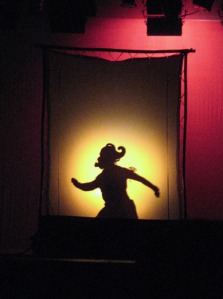
'Siapakah Aku?'
‘Siapakah Aku?’, the second work by Seth, presented a much more straightforward episode. Behind a shadow screen, a man dressed in a Hanuman outfit cavorted like a shadow puppet, charging in profile across the screen with his mask’s jaws snapping and his arms rotating from the elbow. In fits and starts he emerged from behind the screen, then he came downstage where he divested himself of his mask with obvious relief, scratched, hunted out a cigarette, and then wandered offstage asking for a lighter. The audience went wild with approval. In a nice touch, as he crossed the stage he looked back with some puzzlement at the shadow screen, momentarily touched by the dreamlike memory of having been another person, in another world.
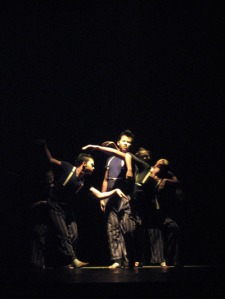
'Thief'.
Azwa’s choreography took the stage again to close the evening on a triumphant note. The costume of white painted eye masks and suspenders over pinstripe pants sounded a classical vaudeville note, while also evoking the work’s title, ‘Thief’. Azwa generally works very closely with his music, and in this case the rhythmic hip hop interspersed with more abstract movement created a sense of momentum. Although some of the dancers lacked technical strength, there were some lovely sustained leaps and capable partner work. In the final scene, white string stretched across the stage under black lights mimicked the look of laser detectors, which the thieves in glowing white gloves nimbly negotiated. The audience clearly enjoyed this touch of theatrical magic, and were sent out into the night buoyed by a new appreciation for contemporary dance, which hopefully will last for some time to come.

Well done, B, one can almost see the dancers and experience the performance…
Pingback: Gorging on dance at the feast for the senses « KL Dance Watch
Pingback: Musings on Malaysian Blackface « KL Dance Watch
Pingback: Musings on Malaysian Blackface « ARTERI